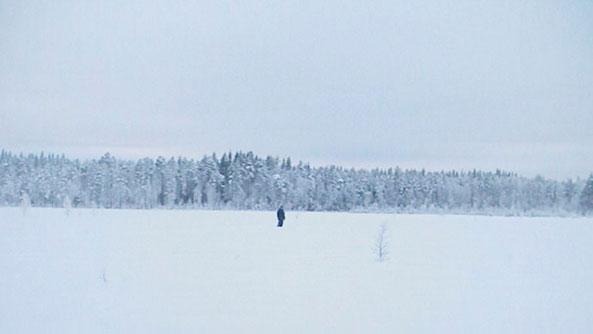"Northern Lights" is director Kristoffer Kiørboe's second film taking up the theme of brothers. His mid-term film, Landscapes, focused on him and his twin brother and their relationship with their father who first came into their lives when they were 21 years old. As the director sees it, sibling relationships are examples of "true love" – love not corrupted by sexuality.
"I'm interested in love stories," Kiørboe says. "Relationships between parents and children, siblings or friends. For me, that type of love has a unique kind of purity."
Wordless interaction
Two brothers drive through a winter landscape in search of the northern lights. In reality they are out to rediscover the intimacy they have lost in the passage of time. It's hard for Simon to get close to his brother Samuel who is brain damaged. He finds it frustrating that Samuel can't sympathize with his life. In one scene Simon probes his brother for a reaction to his leaving for the US to study. Simon never gets an answer as Samuel is unable to express himself verbally.
Sometimes words fall short, Kiørboe says. "I think Simon's need to talk with his brother is a reaction to how he can't sense him. Their lack of intimacy makes him think they need to talk, because that's what people do when they want to get to know each other," Kiørboe says.
In the course of the film, Simon realises that talking won't get him closer to his brother.
"Words can be lacking, and words are unnecessary in Simon and Samuel's relationship. The two brothers have to establish a relationship on a different plane – by experiencing something of beauty together, having a snowball fight, being quiet together, catching each other's glance or simply leaving to find the northern lights," Kiørboe says.
The magic of images
Samuel's silence naturally limits the film's dialogue. But Kiørboe also chose a laconic style because he thinks images, in some types of story, speak a lot louder than words.
"I'm a fan of images. I believe in what I see more than in what's being said. Films are images and images can do special things. A certain light can say more than a thousand words," the director says, striking a blow for aesthetics in documentaries.
In some scenes, the director experiments with the relationship between images and sound, using off-sound of Simon and Samuel's dialogue in a shot of them not speaking, then cutting to a shot where sound and image are in sync. The viewer has to interpret whether the dialogue represents the characters' thoughts or whether they are actually saying what we're hearing.
"It's interesting to drop the dialogue and just have their eyes tell the story. It's fun, too, trying to see what they see and having the dialogue function as a translation of what their facial expressions are saying," Kiørboe says.
The light within
A journey is a good narrative form, Kiørboe says, because there is a set departure and destination. The northern lights are a much less clear destination than any specific geographical point.
"The northern lights are intriguing, because they don't exist in a static place. I don't know how you find the northern lights. Maybe they find you. They are as abstract as what the brothers are looking for on an inner level. They are a metaphor for finding the light within. You can't say what that is, either," Kiørboe says.
Nature overall plays an important role in the film. Kiørboe tried to make the physical settings mirror his characters' inner lives. Simon and Samuel are searching for answers to basic existential questions and that's reflected in the natural scenery.
"My characters somehow or other are looking for God – not necessarily ‘God' in any religious sense of the word but as ‘something' greater than us – as meaning, truth or purity. To me, nature represents that ‘something.' Nature is perfection and purity. It's a good space for putting people in perspective, because we are not so pure. But we can strive for a kind of purity," he says.
Discovering the beauty in the world
Samuel is a grounded character. He just is the way he is. It's Simon who has a problem with Samuel being brain damaged.
"There's a lot less order in Simon's than Samuel's world. That's another reason why the film foregrounds nature the way it does. There's an order to nature that Simon is starting to see. The same beauty and glory in the world, he also sees in Samuel," Kiørboe says.
As the film unfolds, we watch the growing intimacy between Simon and Samuel, but Kiørboe deliberately aimed not to spell everything out for the viewer and tie it all up in a pretty bow.
"I like it that the film leaves them somewhere on the road – that the story isn't resolved. Simon and Samuel may not end up sharing their innermost secrets with each other, but they are headed in the same direction," Kiørboe says. "They are looking for the light."

